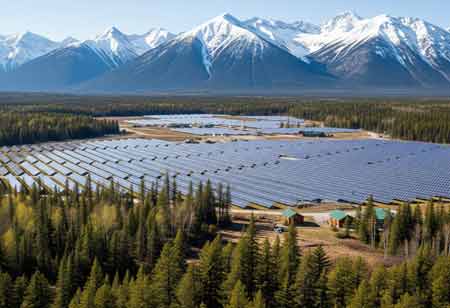Thank you for Subscribing to Energy Business Review Weekly Brief
Canada's Evolving Solar Ecosystem and Innovation Edge
Canada is enhancing its solar power capacity through supportive policies and technology, making significant strides in renewable energy while promoting economic growth and environmental sustainability.

By
Energy Business Review | Thursday, October 30, 2025
Stay ahead of the industry with exclusive feature stories on the top companies, expert insights and the latest news delivered straight to your inbox. Subscribe today.
Canada is steadily advancing its solar power capabilities, establishing itself as a significant player in the global renewable energy landscape. The nation's expansive geography, particularly its southern regions, offers considerable solar irradiation potential, which is increasingly being harnessed through diverse solar energy applications. This evolution is driven by a confluence of supportive policies, technological advancements, and a growing recognition of solar's economic and environmental benefits.
Growth and Geographic Distribution
The installed solar capacity in Canada has seen robust growth over the past few years. As of early 2025, the total installed capacity for wind, solar, and energy storage combined exceeded 24 GW, with solar alone accounting for over 5 GW. This represents a substantial increase in solar capacity, demonstrating a strong upward trend in deployment. Utility-scale solar projects contribute significantly to this capacity, with numerous large installations operational across the country. Alongside these large-scale developments, a burgeoning segment of on-site solar installations, including residential and commercial rooftop systems, is emerging, reflecting a broader public adoption of solar technology for energy independence and cost savings.
Geographically, the development of solar power in Canada is concentrated in provinces that possess optimal solar resources and conducive regulatory environments. Alberta and Ontario have historically led in utility-scale solar deployment, with Saskatchewan and British Columbia also showing notable progress. The Prairies, in particular, benefit from high levels of solar radiation, making them ideal for large-scale photovoltaic (PV) farms. Even in regions with less direct sunlight, such as coastal areas, distributed solar installations are gaining traction, supported by the evolution of grid infrastructure and energy storage solutions.
Policy and Technological Drivers
Government initiatives and policy frameworks play a pivotal role in stimulating solar power development across Canada. Various federal and provincial programs are designed to incentivize solar installations, both for individual homeowners and large-scale developers. These include financial incentives such as tax credits for clean technology investments, low-interest loans for energy-efficient home upgrades, including solar panels, and rebates for solar capacity installed. Net metering programs are widely available, allowing solar users to feed surplus energy back into the grid and receive credits, thereby enhancing the economic viability of solar projects. The broader governmental commitment to achieving net-zero greenhouse gas emissions by 2050 further underscores the strategic importance of renewable energy sources, such as solar.
Technological innovation is continually reshaping the solar energy sector in Canada. Advancements in photovoltaic cell efficiency, including developments in bifacial modules that can capture sunlight from both sides and TOPCon cells, which push conversion efficiencies beyond 24 percent, are enhancing the output and economic competitiveness of solar projects. The integration of energy storage solutions, particularly battery systems, is becoming increasingly common, addressing the intermittent nature of solar generation and improving grid stability. The rise of smart grid technologies is facilitating the seamless incorporation of solar power into the existing electricity infrastructure, optimizing energy flow and enhancing reliability.
Beyond traditional ground-mounted and rooftop installations, emerging trends in solar technology are expanding the applications of solar power. Building-integrated photovoltaics (BIPV), such as solar shingles and transparent solar facades, are gaining popularity, offering aesthetically pleasing ways to integrate solar generation directly into building designs. Agrivoltaics, the practice of co-locating solar panels with agricultural activities, is another innovative approach that optimizes land use, providing dual benefits of energy production and agricultural yield. Floating solar power plants are also being explored, particularly in regions where land availability for conventional installations is limited.
Economic Impact and Future Outlook
The economic impact of solar power development in Canada is a significant contributor to job creation, encompassing roles in installation, manufacturing, sales, maintenance, and research and development. These jobs are often localized, contributing directly to community economic growth. Investments in solar projects, both domestic and international, stimulate economic activity, support research and development in new technologies, and foster innovation within the clean energy ecosystem. The increasing adoption of solar energy contributes to national energy independence by reducing reliance on imported fossil fuels, thereby enhancing economic resilience against fluctuations in the global energy market. The long-term energy savings realized by residential and commercial solar users also free up capital that can be reinvested into other areas of the economy.
Canada’s abundant solar resources, supportive policies, and advancing technologies position the country for strong and sustained growth in solar power. The pursuit of ambitious climate targets, including significant reductions in greenhouse gas emissions, necessitates a substantial shift towards renewable energy, with solar being a cornerstone of this transition. As the cost of solar technology continues to decline and efficiency improves, solar power is set to become an even more competitive and integral part of Canada's diverse energy mix. The focus will increasingly be on enhanced grid integration, advanced energy storage solutions, and innovative applications that maximize the utility and penetration of solar energy across various sectors, further solidifying its role in powering Canada's sustainable future.






